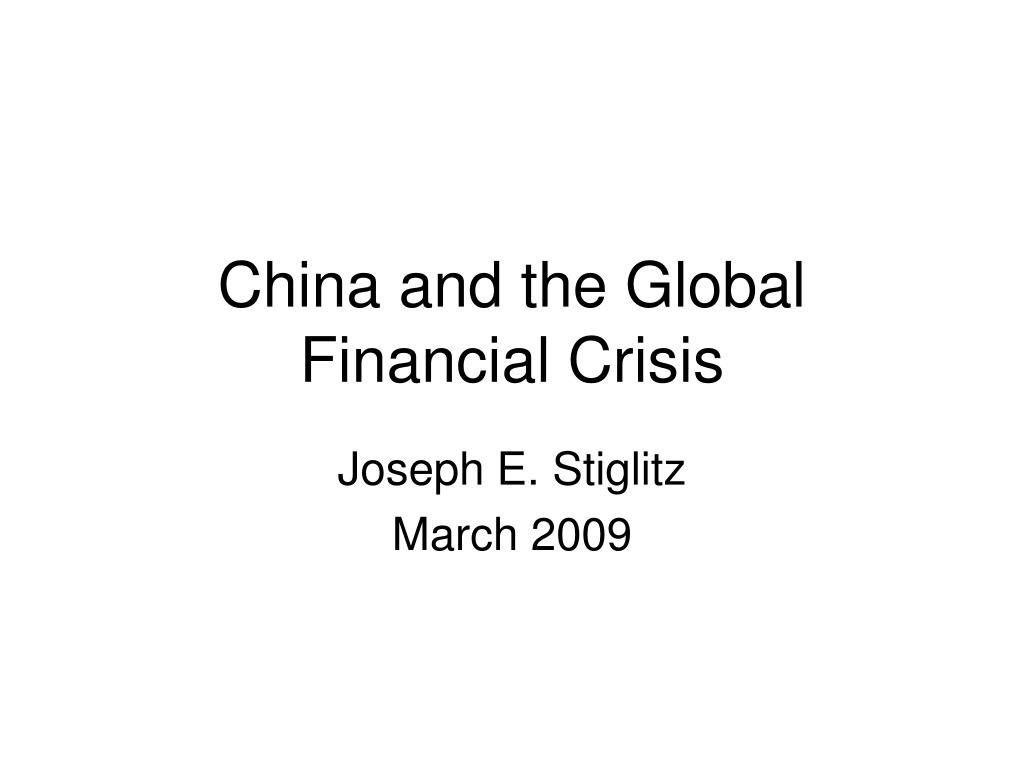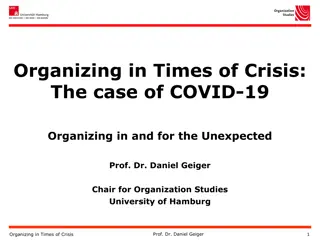The Global Financial Crisis: Impact on China and the Global Economy
The global financial crisis described by Joseph E. Stiglitz in March 2009 highlights the interconnectedness of economies and the challenges faced by various countries. The crisis has led to a deep and prolonged downturn affecting both developed and developing nations, debunking the myth of decoupling. Strains on countries include decreased exports, lower investment, anxieties about future income, wealth reduction, unemployment, and lower consumption. Recovery is deemed difficult as a global effort is essential, yet responses remain largely at the national level. The crisis demands a global response for effective recovery.
Download Presentation

Please find below an Image/Link to download the presentation.
The content on the website is provided AS IS for your information and personal use only. It may not be sold, licensed, or shared on other websites without obtaining consent from the author. Download presentation by click this link. If you encounter any issues during the download, it is possible that the publisher has removed the file from their server.
E N D
Presentation Transcript
China and the Global Financial Crisis Joseph E. Stiglitz March 2009
A Deep and Prolonged Downturn The first truly global downturn of the modern era of globalization Downturn in the U.S. will be the most severe since the Great Depression And may be even more difficult to deal with With huge losses in the financial sector
The Myth of Decoupling All countries are being affected America exported its toxic mortgages America exported its deregulatory philosophy Now America has exported its recession Developing countries that have been most successful in enmeshing themselves in the global economy are likely to be most adversely affected Through unprecedented decreases in exports Through massive changes in capital flows Irony: capital is flowing back to the US from which the crisis originated Even countries that have pursued good economic policies (e.g. better bank regulation than the U.S.) are being affected
This crisis will put great strains on all countries Not only decreased exports, but also lower investment Anxieties about future income, decreases in wealth, reducing ability to borrow, higher unemployment all contribute to lower consumption Risk of high unemployment In China, reverse migration new strains on rural sector
Recovery will be more difficult In the past (such as the East Asia crisis) countries could export their way out of a downturn But this is a global crisis So this is not an option the only option is for the global economy to recover together
A Global Crisis Requires a Global Response Yet responses are still at the national level Because of externalities (benefits that accrue to others) the size of the stimulus is likely to be too small And countries are likely to try to maximize domestic multipliers undermining effectiveness of global multipliers Implying that the global recovery will be slower than it otherwise would be
Analysis of the Crisis This is a classical recession with a lack of aggregate demand But there are also supply side effects lack of availability of credit, and increasingly, firms with limited net worth, many being forced into bankruptcy With a consequent loss of informational and organizational capital Bankruptcy and near bankruptcy of financial institutions especially problematic
Crisis fundamentally different from most downturns Inventory cycles once inventories depleted, economy restarts Central bank steps on brakes too hard because worried about inflation Realizes mistakes, takes foot off brake, puts gently on accelerator, and economy quickly recovers Damage to institutions (especially financial institutions) is long lasting and hard to repair
Demand and supply are intertwined Huge losses in firms with downward shift in demand Huge reductions in demand for investment, inventory holding, and risk taking as firms balance sheets deteriorate
US says that restoration of financial system is necessary for restoration of the economy But restoration of financial system is not sufficient There will still be a problem of lack of demand For example from reduced consumption As America s savings rate returns to more normal level
Restoration of the financial system will not be easy Bank bail-out very costly, not restarting lending Backward looking, rather than forward looking $700 billion in a new lending facility, leveraged 10 to 1, would have created $7 trillion in lending capacity Should have put more emphasis on recapitalizing good banks that actually do lending, rather than zombie investment banks that have been engaging in gambling Should have put more emphasis on reducing risk for new loans Worry--Zombie banks being kept alive, needing repeated funds, perverse incentives, not in national interest Government getting bad deal (as little as 25 cents on the dollar in shares, shares plummeting in value, remaining share value related to bail-out option)
Huge government borrowing needs, increased deficits compromising governments ability to undertake other objectives Again, effects may be long lasting Government buying bad assets at too high a price or assuming downside risks is NOT the solution simply shifts losses from private sector to public Socializing losses while leaving gains in private sector is recipe for disaster NOW, even if we were to restore capacity and willingness to lend, there may be lack of demand for funds downward vicious circle
Crisis exposed fundamental flaws in system Not just a matter of a few rotten apples Not just a matter that they were unprepared for a once in a century tsunami they created tsunami Evolutionary processes failed excessive risk takers drove out more prudential firms
Massive market failure Huge demands in US, and world Investment required to retrofit world for global warming Problems of poverty Combined with massive unemployed resources Both labor and capital Massive market failures leading up to crisis Important lesson for how to run a market economy
Implication Not just a minor repair job slight tweaking in the system Rather, more fundamental reforms in the economy America s economy has not served its citizens well even before crisis: most have incomes lower in 2007 than in 1999; most face high levels of economic and health security
But Americas new economic model Corporate Welfarism or Ersatz Capitalism socializing losses and privatizing gains, is likely to be even worse Both for most citizens And for the aggregate economy major misalignment of incentives
Designing a Good Stimulus Big global multiplier Help redirect economy in ways consistent with the vision of the future and address long standing needs not recreating failed system of the past Good investments create an asset, offsetting the liability of increased government deficits (or reduced reserves)
Flexibleautomatic stabilizers that spend more when and if more is needed Plans for sequential stimuli if more is needed Sensitive to micro-economics where are jobs being lost, where are they being created
This is an Opportunity for China 11th Five Year Plan set out an agenda for harmonious, sustainable growth a long run vision Increasing domestic consumption and investment, less export dependent An innovation economy More environmentally sustainable growth Helping the rural sector More broadly promoting social harmony
Crisis may provide an opportunity to carry forward this agenda but it will not be easy China has always adapted policies to changing circumstances These are dramatic changes in circumstances
Large and well designed stimulus Focuses on the transformations outlined in 11th five year plan China has been engaged in vendor finance Vendor finance can be used to support domestic consumption and investment Raising living standards of those in China Providing basis of long term growth As it stimulates the economy in short run Just as measures taken in 1997/1998 crisis provided foundations for growth in subsequent decade
Large and well designed stimulus Helping those in the rural sector promote equality and consumption Identifying other weaknesses in the economy and by addressing these, help lay foundations for future growth Better rental housing market focusing on low income housing (up 171%) could help labor mobility Better financial markets for small and medium sized enterprises and for the rural sector
Better social protections (health and education and retirement), especially in the rural sector promote consumption (healthcare up 38%, education 24%) Promoting service sector and other labor intensive industries NOT promoting sources of imbalances and environmental problems Public transportation, not private automobiles
Finding the right balance Question--does the current stimulus package strike the right balance? Does it spend enough in promoting innovation and promoting the environment? Does it spend too much on large infrastructure projects and promote certain priority sectors possibly increasing supply/demand imbalance?
A Deeper Look: Why is Chinas Savings Rate So High? Household savings rate only slightly too high better social protections would have both direct and indirect effects on consumption Small businesses have a high savings rate because of lack of access to capital Unusually high level of income in corporate sector, unusually high profits, and unusually high retained earnings partially reflection of low wages Need to develop provincial and local banking system encourage small and medium sized enterprises (often labor intensive) Competition for labor might lead to higher wages Competition for funds might lead to higher payouts
High profits contribute to high level of investment Mismatch between growth in supply and growth in demand Disparity made up by exports But that may be difficult now With resulting deflationary pressures With accompanying macro-economic risks
May be key sectors with market distortions Underpricing of natural resources full pricing would generate public revenues for public investment, e.g. in research and environment Telecom problem in many countries of the world KEY ISSUE IS CONTINUING THE TRANSFORMATION OF THE CHINESE ECONOMY TO A MARKET ECONOMY BUT A MORE HARMONIOUS AND SUSTAINABLE MARKET ECONOMY
Concern about Americas Response Costly delay often takes months before full effects of stimulus are felt Stimulus too small, given the magnitude of the problem About half offset by negative stimulus from states and localities Stimulus not well designed About a third in tax cuts, likely to have limited effect
Learning the Lessons from America s failure Better regulation, especially in the financial sector But also in corporate governance perverse incentive structures And better regulatory structures enforcement matters Competition policy we allowed banks to grow too big to fail Monetary policy framework flawed Need to pay attention not just to inflation Many seemed to think that low inflation was necessary and almost sufficient for strong growth Never was evidence or good theory in support of this view Now it is clear how wrong that view was Need also to pay attention to financial stability
Learning the Lessons from and for Globalization Globalization can bring benefits But also problems contagion Crises can spread quickly around the world China needs to be careful about financial and capital market liberalization Spirit and letter of international agreements are being broken Worry about protectionism But Buy America provision is protectionist, and details of wording may be worse, discriminating against developing countries Subsidies (bail-outs, guarantees, some government lending facilities) are even more distorting of global market place than tariffs Developing countries can t match No longer question of a level playing field, especially in financial services Long-run implications for the nature of an open, competitive, fair global market place Worry that some international agreements hamper flexibility needed to respond to crisis Restrictions on imposing needed regulatory reforms
This is a global crisis requiring a global response New global regulatory system must be comprehensive to avoid regulatory arbitrage and go well beyond just transparency Problem shifting to developing countries They don t have funds to respond Need for additional financial support Without usual counterproductive, procyclical conditionality If this doesn t happen, global imbalances will grow, robust recovery will be at risk Reforms needed in international financial institutions Not only didn t address problems before they occurred Also pushed policies that contributed to the crisis Those with liquid funds have inadequate voice
Three Key Recommendations of UN Commission A new Global Credit Facility, with better governance than existing institutions A Global Economic Coordinating Council A new Global Reserve System Problems in global reserve system at heart of global imbalances Contributing to insufficiency of global aggregate demand Problem long recognized (Keynes) Current system is fraying Now is the time to initiate reforms
China has vital role to play in global recovery Maintaining strength of its own economy through appropriate macro-economic policies Contributing to a balanced global recovery, through assistance to developing countries Working, through G-20 and the UN, to make the reforms that will be necessary to restore confidence and make a more stable global economy























